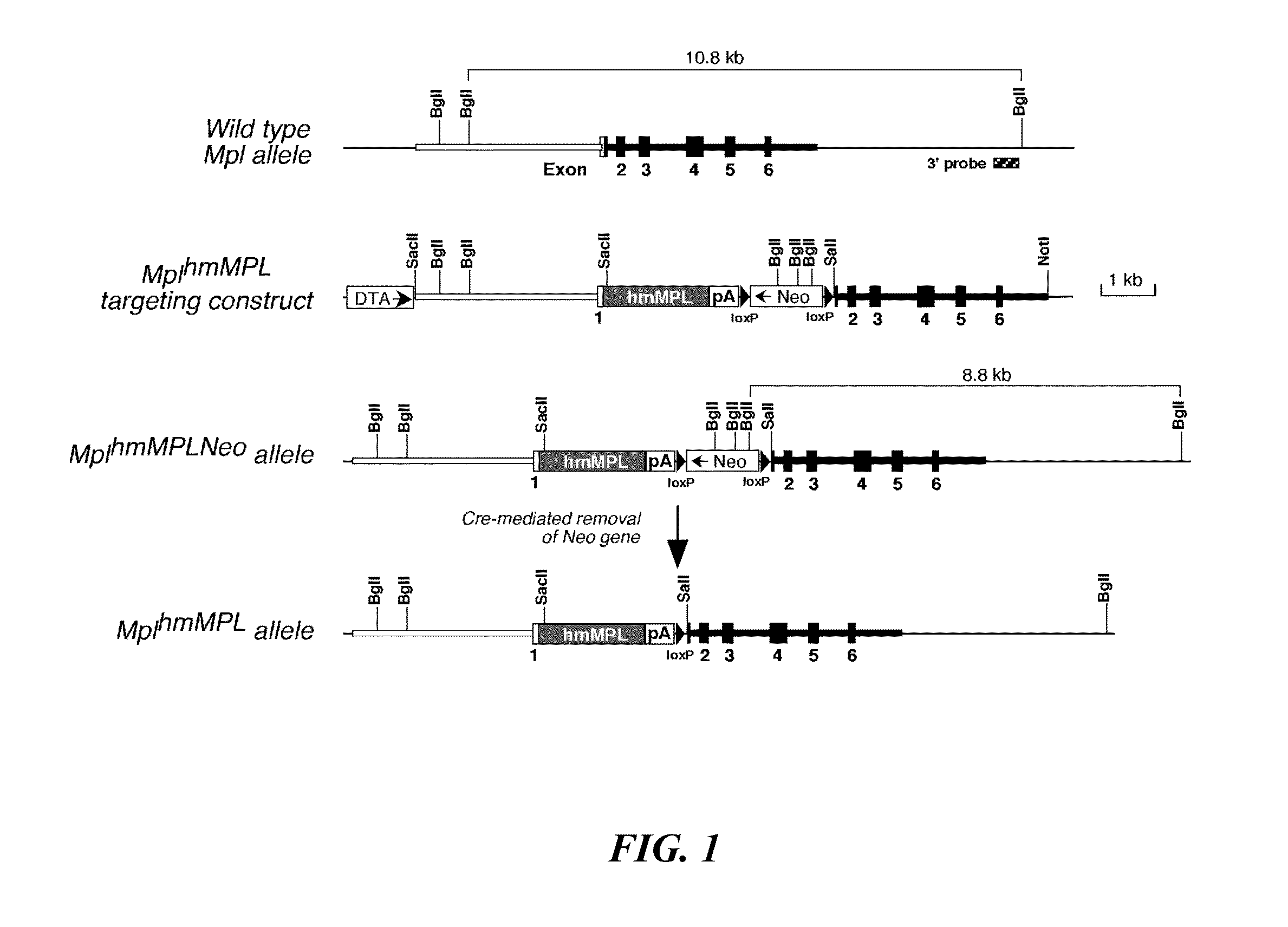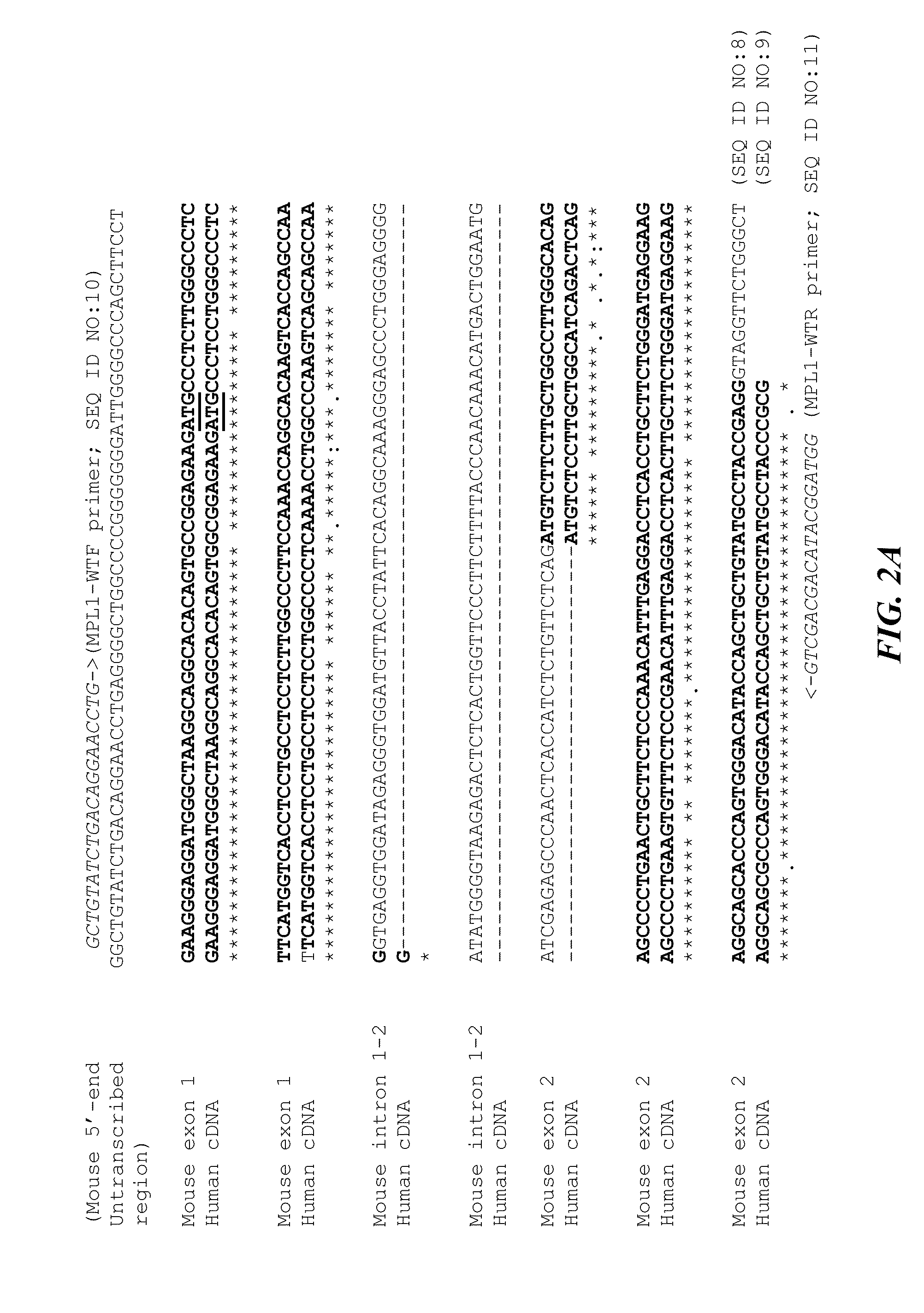Thrombopoietin mimetics for the treatment of radiation or chemical induced bone marrow injury
a technology of thrombocytopenia and bone marrow injury, which is applied in the direction of immunoglobulins, peptides, drugs against animals/humans, etc., can solve the problems of thrombocytopenia and associated deaths from hemorrhage, thrombocytopenia and the risk of sepsis and death remain unresolved clinical problems
- Summary
- Abstract
- Description
- Claims
- Application Information
AI Technical Summary
Benefits of technology
Problems solved by technology
Method used
Image
Examples
example 1
Generation of Human TPO Receptor (c-Mpl) cDNA Knock-in Mouse / MplhmMPL
[0359]To generate human c-mplc DNA knock-in mice, mouse 129S6 BAC genomic DNA was obtained from The BACPAC Resource Center (BPRC) at the Children's Hospital Oakland Research Institute in Oakland, Calif., USA. The MplhmMPLNeo knock-in construct was generated by inserting 3.5 kb c-mpl 5′ flanking sequence ending at the 20th nucleotide upstream of the translation initiation codon ATG and 4.0 kb 3′ sequence starting from the 18th nucleotide upstream of ATG into 5′ and 3′ multiple cloning sites of pKIIlox vector at the SacII-XhoI and SalI-NotI sites, respectively. The SalI-SalI human-mouse hybrid cDNA fragment, which contains human mpl extracellular and transmembrane domains (amino acids 1-513, NCBI Accession No. NM—005373), mouse mpl cytoplasmic domain (amino acids 513-633, NCBI Accession No. NM—001122949), and a SV40 polyadenylation sequences, was inserted at an XhoI site at the 3′ end of the 5′ flanking sequences (F...
example 2
Experimental Verification of Human TPO Receptor (c-Mpl) cDNA Knock-in Mouse MplhmMPL at the DNA Level (Genome Typing)
[0360]To experimentally verify that the human c-mpl cDNA sequence encoding the extracellular and trans-membrane domains was successfully knocked into the mouse genome, genomic DNA PCR was carried out using a mouse-specific forward primer and a common reverse primer. As shown in FIG. 2A, the forward primer (SEQ ID NO: 10) corresponded to the 5′-end un-transcribed sequence upstream of the mouse c-mpl gene. The reverse primer (SEQ ID NO: 11) corresponded to an exon 2 sequence where human and mouse genes are identical. Since the human cDNA KI mouse lacks introns, the PCR product of KI mice is shorter than that of the wild-type mouse mpl genomic transcript. Thus the homozygote human cDNA KI mouse yields a PCR product of 309 bp while the wild-type mouse yields a PCR product of 462 bp. The heterozygote mouse yields both PCR products since it carries both human cDNA and mouse...
example 3
Sequence Design and Construction of Human TPO Receptor (c-mpl) Exon 10 Knock-in MouseMplhExon10
[0364]For both human and mouse, the trans-membrane domain (TM) of the TPO receptor (c-Mpl) is encoded by exon 10 of the c-mpl gene. The DNA sequences of human and mouse exon 10 are aligned in FIG. 4. The alignment reveals that the two genes are highly homologous; however, there are a total of 15 base pairs that are different. Human exon 10 sequence was used as a cassette for inserting into the mouse genome to replace its mouse counterpart sequence as described below, resulting in an c-mpl exon 10 mouse knock-out / human knock-in mouseMplhExon10. The rest of the mouse c-mpl gene remains intact.
[0365]Alignment of the exon 10-encoded amino acid sequences of the two species revealed that 5 amino acids are different between them, four of them being in the trans-membrane domain. Thus the c-mpl exon 10 mouse knock-out / human knock-in mouse generated produces a TPO receptor (c-Mpl) with exactly the ...
PUM
| Property | Measurement | Unit |
|---|---|---|
| diameter | aaaaa | aaaaa |
| Mpl genomic structure | aaaaa | aaaaa |
| thick | aaaaa | aaaaa |
Abstract
Description
Claims
Application Information
 Login to View More
Login to View More - R&D
- Intellectual Property
- Life Sciences
- Materials
- Tech Scout
- Unparalleled Data Quality
- Higher Quality Content
- 60% Fewer Hallucinations
Browse by: Latest US Patents, China's latest patents, Technical Efficacy Thesaurus, Application Domain, Technology Topic, Popular Technical Reports.
© 2025 PatSnap. All rights reserved.Legal|Privacy policy|Modern Slavery Act Transparency Statement|Sitemap|About US| Contact US: help@patsnap.com



